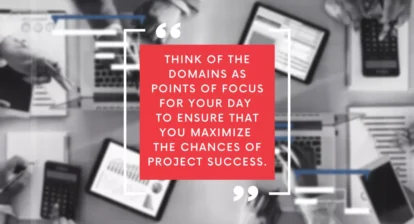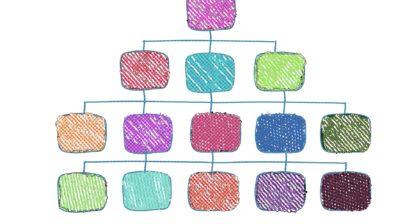Aristotle was a great philosopher, but it’s my belief that if he had lived today, he would have become a great project manager. Living in 4th century B.C., Aristotle wrote a series of books on politics. He gave reference to the popular proverb, “Well begun is half done,” in one of his treatises. He wrote: “The mistake lies in the beginning; as the proverb says, ‘Well begun is half done;’ so an error at the beginning, though quite small, bears the same ratio to the errors in the other parts.”
This wisdom is as relevant today (and maybe even more so), as it was a few centuries ago. In today’s world, we can easily deduce that the chances of successfully completing a project become higher if you begin it well.
An important question arises: how DO you start a project?
In one of my previous posts, I wrote about the role of a project manager and listed responsibilities as they related to five different process groups. Let’s look at properly starting a project from this basis.
1. Start with Understanding the Project
You might not get much information about the project at the start, but you should look at the feasibility study documents, the contract, the statement of work, and the project brief.
As a project manager, you should thoroughly read these documents and take notes about following aspects of the project:
- Project goals
- Project timeline and budget
- Stakeholder expectations with respect to the scope of work and final deliverables
- Success criteria, which might include things like on-time delivery, sticking to the defined budget, and handing over a defect free product
Do not hesitate to call your client or other stakeholders if you are not sure of something. It is absolutely essential that you gather as much information as possible before you proceed to the next step.
I usually hold a series of meetings with main stakeholders at the start of the project. I probe them about the project and ask them about their expectations from the project. I also try to gauge how can they help me in completing my tasks. You can do the same thing. Remember that this is your project, and it is your neck which is on the line. So, do what you have to do to gather as much information as possible. You may have to meet with stakeholders several times before you get the required clarification. Remember: “Well begun is half done.”
2. Define Key Objectives
After you have gathered the initial information about the project and understand the Project Goals, you should start defining the key objectives of the project. Goals are different from objectives. A goal is like a vision that defines the project outcome. It provides a summary of the project’s purpose. Goals are generally very broad and are not measurable. Objectives, on the other hand, are specific actions that can measured.
While defining project objectives, ensure that everyone is aligned with both the project and the organizational goals. Use the SMART framework (below) to write effective project objectives:
- Specific
- Measurable
- Achievable
- Relevant
- Time-bound
For example, a project goal might be to improve the customer service. Converted to a SMART objective, it would be: Increase the average customer satisfaction ratings from 4.3 to 4.5 over a period of six months.
You should collaborate and validate project objectives with senior stakeholders, including the project sponsor and customer before proceeding further.
3. Develop a Project Charter
Start creating the project charter after you have thoroughly understood the finer elements of the project and defined its objectives. A project charter is one of the most important documents in a project; if not the most important. It is essential for defining the project’s purpose and communicating the same to stakeholders.
The project charter authorizes the existence of the project and defines its essential elements. According to the PMBOK Guide, the project charter not only authorizes the existence of the project, but also gives the project manager the authority to use organizational resources for project activities.
Generally, project charter is a small document. The major elements are:
- Vision and purpose
- Description
- Objectives
- High level scope and requirements
- High level milestone schedule
- Overall budget
- Initial risks
- Main stakeholders and their respective roles
- Project manager’s name
- Project sponsor’s name and signature
Although the objectives, timeline, and deliverables of a project may change over time, the project charter builds a foundation for the project team. After putting together the project charter document, you should get it signed by the project sponsor. It has no significance without the sponsor’s signature.
4. Hold a Kick-off Meeting
Hold a project kick-off meeting after your project charter is ready. The charter can be circulated to the attendees before the meeting is held, but this gives you a chance to explain the ingredients of the charter to everyone involved with the project.
The main purpose of the project kick-off meeting is to formally launch the project and get it off the ground. This meeting serves as a starting point for the project where the stakeholders get to understand the nature of the project and its overall objectives. The meeting provides direction and clear next steps for executing the project.
Here a some of the main ways a project kick-off meeting can help the project get off to a good start:
- Introduces main stakeholders to each other and explain their respective roles in the project
- Establishes a common understanding for the project
- Defines the success criteria
- Establishes a shared understanding of the tasks that are required to be completed
- Gains commitment from the stakeholders
- Acts as a forum for the project team, project sponsor, and other main stakeholders to get on the same page
A successful kick-off meeting can be the key to set the tone and direction for the project. If a kick-off meeting is done correctly, it can make a huge difference in the success of the entire project.
Note: In some organizations, the project kick-off meeting is held to prepare the charter.
Over to you
Which other things do you do while initiating a project?
Do you think project charter adds value to the project especially when the project parameters change over a period of time? Is it important to talk to the stakeholders at the beginning of a project or can it be left for later stages?
I would love to hear from you in the comments below.







